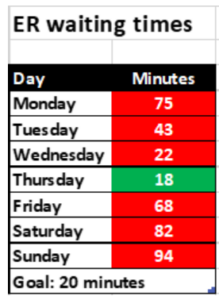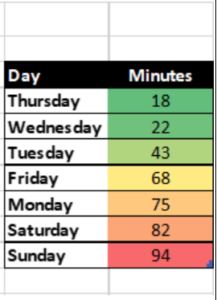As the Saying Goes, There Are Lies,
Damn Lies, and CX Data
Persuasion and the presentation of CX data
“Hard to port, hard to port now!”
Neutral does not exist. Context, also called ‘framing’, always biases our reception in one direction or another. To stretch a point, “Hard left, hard left now!” means different things in a street demo or in the wheelhouse of the Titanic.
Whether implementing a CX initiative or explaining CX data, always bear context in mind. We offer some instructive examples below.
Homicides committed by mentally ill patients not taking their meds!
“Approximately 1,000 homicides a year are committed nationwide by seriously mentally ill individuals who are not taking their medication!” In the USA, that is.
That’s a powerful statement. Should we panic?
This is a different framing of exactly the same data: The annual probability of a given person being killed by a mentally ill patient not taking their medication is 0.0000036.
Pale consolation, but you are much more likely to drown.
The initial quote is a great example of how to manipulate us into thinking in a particular way. It comes from a paper by Torrey and Zdanowicz written in 1998.
Note how the quote uses an absolute number. If you want folks to act, use numbers. If you don’t want them to act, use a probability or a percentage.
There is an important message for CX professionals. The way that you present data can greatly alter your audience’s willingness to act. Present for the result that you need.
if you want folks to act, use numbers. If you don’t want them to act, use a probability or a percentage.
Can numbers have emotions?
We increasingly see automated road signs displaying the speed at which you are driving. The earliest versions just displayed numbers. They were somewhat effective, though they occasionally had a sort of perverse result. A small fraction of drivers used them to see how fast they could go on that stretch of road. Far more commonly, drivers sped up if they were well below the limit.
Progressive authorities have replaced these signs with ones that change color and display a happy face if you are under the limit. You see a red and unhappy face if you are driving too fast. (Our entire team deny ever having seen such an unhappy face while driving, so all of this could just be a rumor.)
The new signs are far more effective in reducing average speeds. Why? Data shows that it is primarily the expression of a human emotion that is the nudge we need. We want to make the face smile.
CX professionals may want to experiment with this effect in other contexts. In moderation, please!
Q: What is a good NPS number?
A: A better number than you had last time
Cognitive Dissonance – Too much red will kill your message
It is very tempting to set absolute standards for all your CX and operational metrics. Average time to respond to a call should be under 12 seconds. Product delivery time should be under three days. NPS should be at least 55. Error rates for your orders should be under 1.2%. And so on.
It seems rational to have rock-solid targets, and particularly so if they are based on competitive data. However, this type of goaling presents major communication challenges.
One way of thinking about the CX goal of any company is that it should be continuous improvement, whether measured financially, operationally, or in terms of customer or employee happiness. This means that the answer to the common question, “What is a good NPS number?” would be “A better number than you had last time.”
In this spirit, we recommend that evaluation and presentation of scorecards be about progress, not absolute numbers. If products, services, projects or brands are being compared in a performance table, focus more on relative performance rather than always against a specific goal.
We have a reason for taking this position: the well established phenomenon of Cognitive Dissonance. When we get new information that differs from what we already believe, we have a choice. We change our minds, or we reject the new evidence. We have a strong tendency to hold on to what we believe.
So if you show a scorecard that is full of unexpected red numbers (or indeed of unhappy faces), prepare for it to be ignored. In such a context, showing performance as relative will cause less dissonance, be more convincing, and work far better as a motivator.
Consider the story of Pedro, the head of Patient Experience at a large and successful private hospital near Houston. He is new and has to make his first presentation to the leadership team. He has gathered operational and satisfaction data from various departments.
Pedro can choose at least the two ways of looking at waiting times in the hospital emergency room, as shown below:
 |
 |
Which should he choose? It would be nice to think that the people receiving the left-hand table would react maturely. Unlikely.
Cognitive dissonance kicks in. The leadership team consider themselves highly successful. Their brains delete contrary information. For the ER data on the left, their reaction is to think, “There is so much red on this table that there is clearly something wrong with it.”
Not so when presented with the table on the right. It is easy to see that the performance on Sundays is awful, in relative terms. There is no implication that the whole service, and by logic the whole leadership team, is awful.
The table on the right should lead to a meaningful discussion about weekend staffing levels. At the very least there will be positive engagement on the topic of waiting times.
Conclusion
These are three examples of presentation techniques that will stimulate action. Or not – you do not always want action to be taken!
Use these cognitive techniques selectively. Employ them for the few items where you really want your audience to act.
ABOUT INSIGHTS FROM OCX COGNITION
OCX Cognition delivers the future of NPS. We ensure customer experience success by combining technology and data science with programmatic consulting. In our Insights section, we present a comprehensive and evolving collection of resources based on our research and expertise, collected for CX leaders committed to delivering business outcomes.
